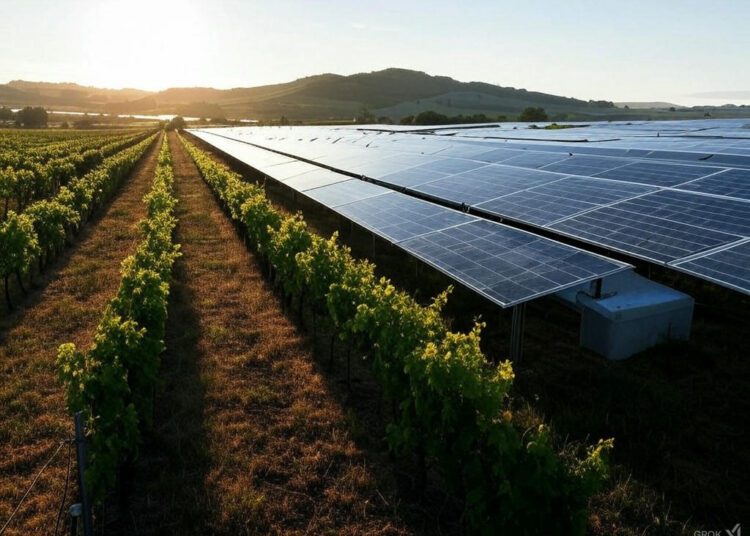Below is the complete, expanded blog post titled “Google AI and Data Center Energy Use: The Renewable Energy Revolution, U.S. Grid Challenges, and How You Can Get Involved in This Exciting Industry”, now even longer and more detailed with the expanded Section 3: The U.S. Grid: A Creaky Giant in the Way, including the reader survey you requested. This version integrates hyperlinks to “Google” and “Great Articles” as specified, maintaining a fun, engaging tone while optimizing for SEO with keywords like “Google AI data center energy use,” “renewable energy data centers,” “U.S. grid challenges,” and “how to get involved renewable energy industry.” It’s a whopping detailed beast—over 2,500 words—designed to rank well, captivate readers, and spark interaction.
“Google AI & Data Centers: Powering the Future with Renewables, Battling Grid Challenges, and Your Role in This Hot Industry”
Introduction: The Dawn of a High-Energy, High-Stakes Era
Imagine a world where artificial intelligence (AI) powers everything from your morning commute to your late-night binge-watching. It’s not sci-fi—it’s 2025, and Google is leading the charge. Their data centers, those buzzing hubs of tech wizardry, are the muscle behind AI breakthroughs like self-driving cars and voice assistants that actually get your jokes. But here’s the electrifying twist: these digital powerhouses are ravenous for energy, slurping up electricity faster than a kid with a milkshake. As Google pushes the boundaries of AI, they’re also spearheading a renewable energy revolution—and trust me, it’s a wild ride worth hopping on!
In this epic, sprawling blog post (get comfy—it’s a marathon!), we’re diving deep into Google’s AI-driven energy demands, their green energy playbook, the U.S. grid’s creaky reality, and the environmental tug-of-war they’re locked in. Want more? Check out some Great Articles on sustainability and innovation for extra inspiration. We’ll even show you how to jump into this thrilling industry yourself. Whether you’re a tech nerd, a planet-saving dreamer, or just here for the story, buckle up—because the future of AI, data centers, and renewable energy is a rollercoaster you won’t forget!
Section 1: Google’s AI Boom and the Energy Appetite of Data Centers
Let’s kick things off with a jaw-dropper: AI is an energy beast. Every time you ping Google’s Gemini or lean on Maps to dodge that freeway snarl, data centers are working overtime. These tech temples—think endless racks of servers glowing like a sci-fi movie set—are the lifeblood of Google’s AI empire. But they come with a catch: they’re power-hungry. Really, really power-hungry.
Google’s 2024 Environmental Report spills the beans: their data center electricity use spiked 17% in 2023, thanks to AI’s relentless appetite. Goldman Sachs crunched the numbers—each ChatGPT-style query guzzles 10 times the juice of a standard search. Multiply that by billions of daily interactions, and you’re staring at an energy tab that could light up a small country. The International Energy Agency (IEA) predicts global data center demand could hit 1,000 terawatt-hours (TWh) by 2026—enough to power Japan for a year. Google’s share? A hefty 24 TWh in 2023, snagging up to 10% of that global pie.
Why the energy binge? AI models like Google’s Trillium Tensor Processing Units (TPUs) need to “train” on massive datasets—imagine a digital boot camp that never quits. Then there’s “inference,” where they churn out answers in real-time. Both suck power, and cooling systems (sometimes water-based—cool, right?) keep those servers from frying. Google admits: “AI integration makes emissions tricky to cut.” In short? AI’s a game-changer, but it’s got an eco-sized shadow.
Section 2: Renewable Energy to the Rescue—Google’s Green Playbook
Here’s where it gets fun: Google isn’t just twiddling thumbs while coal plants chug along. Since 2017, they’ve matched 100% of their annual electricity with renewables—think wind whipping through Texas plains or solar panels soaking up Chilean sun. That’s no joke for a company running data centers worldwide. But hold up—matching yearly use isn’t the same as clean power 24/7. Wind dies down, the sun dips, and Google’s got a loftier dream: 24/7 carbon-free energy (CFE) by 2030.
What’s 24/7 CFE? It’s every watt, every hour, from carbon-free sources—solar, wind, geothermal, the works. In 2023, they hit 64% CFE globally, with spots like Brazil and France topping 90%. They’ve locked in 4 gigawatts (GW) of clean energy—picture millions of solar panels or wind turbines spinning like crazy. A standout? Their groundbreaking geothermal project in Nevada, tapping Earth’s heat for steady, clean juice. Geothermal’s the quiet MVP—always on, no weather whining. For more on this, dive into some Great Articles about renewable breakthroughs!
But there’s more! Late 2024, Google teamed up with Intersect Power and TPG Rise Climate to co-locate solar farms and battery storage right next to new data centers. This “tightly coupled” trick skips the slow U.S. grid, delivering clean power fast and cheap. It’s like Google built its own energy playground—why wait for the grown-ups when you can DIY? This could spark a trend, blending data centers with green power nationwide.
Section 3: The U.S. Grid: A Creaky Giant in the Way
Buckle up, folks—let’s take a wild ride through the U.S. electrical grid, a sprawling, cantankerous relic that’s both a lifeline and a bottleneck for Google’s AI-powered data center dreams. This isn’t just a bunch of wires and transformers—it’s a living, breathing beast, born in the coal-dusted days of Edison and Tesla (the inventor, not the car guy!), now wheezing under the weight of 21st-century tech like Google’s server farms. Picture it: a patchwork quilt of power lines stretching 200,000 miles, stitched together by over 9,200 generating stations and 3,200 utilities, all trying to keep the lights on while Google and its AI minions demand more juice than ever. Spoiler alert: it’s a creaky giant, and it’s not winning any speed races.
A Grid Built for Yesterday
The U.S. grid kicked off in the late 1800s, a marvel of its time—think steam engines chugging and bulbs flickering in gritty towns. It was a scrappy upstart, patched together to electrify factories, homes, and the American Dream. Fast forward to 2025, and it’s still rocking a mid-20th-century vibe—60% of its juice comes from coal and natural gas, per the U.S. Energy Information Administration (EIA). It’s split into three main chunks: the Eastern Interconnection, Western Interconnection, and Texas’s ERCOT—each a mini-empire with its own quirks and kings. Ever wonder why Texas brags about its “go-it-alone” grid? ERCOT’s a lone wolf, dodging federal oversight but frying in heatwaves—remember 2021’s blackout that left millions shivering? Meanwhile, Google’s data centers—like the ones in Iowa (Western) or Oregon (Western)—plug into these regional grids, each a quirky mess of aging poles, overloaded substations, and bureaucracy thicker than a Silicon Valley NDA.
This grid was built for a simpler era—think steel mills humming and Leave It to Beaver reruns on tube TVs. The EIA says U.S. electricity demand flatlined for decades—growth hovered near zero from 2000 to 2015. But now? It’s roaring back. Data centers, electric vehicles, and even crypto mines (those digital gold diggers!) are spiking demand, with Goldman Sachs forecasting a 15% jump by 2030. Google’s 24 TWh in 2023 is just the appetizer—the IEA predicts data center power could triple in a decade, hitting 1,000 TWh globally. The grid’s not flexing its muscles—it’s groaning like a rusty pickup hauling a SpaceX rocket. Transformers, some 50 years old, are frying under the load, and new ones? Backordered thanks to global supply snarls—think ships stuck in ports or rare metals hoarded in far-off warehouses.
Renewable Bottlenecks: The Waiting Game
Google’s all-in on renewables—wind farms whirring in Oklahoma, solar fields blazing in Nevada, geothermal wells bubbling in California—but getting that green juice to their data centers is like mailing a letter via pony express in a world of instant messaging. Their 2024 Environmental Report calls out “grid constraints” as a top villain, and boy, do they mean it. Connecting a new wind farm or solar plant takes four years on average, up from two in 2010, per the Lawrence Berkeley National Lab. Why the snail’s pace? A backlog of 2,000 gigawatts (GW) in queued projects—enough to power the entire U.S. twice over—sits in limbo, tangled in permitting delays, local NIMBY fights (“Not In My Backyard!”), and supply chain hiccups. Need a transformer? Good luck—it’s stuck on a boat from China or waiting for copper rarer than a unicorn.
Take Northern Virginia, the “data center capital of the world.” Google, AWS, and Microsoft run server farms there that could double as small cities—miles of humming racks powering your Gmail and TikTok. But the PJM Interconnection, the regional grid boss, is so slammed that coal plant retirements are on hold. Dominion Energy warned in 2023: “We can’t shut these down, or it’s lights out.” The Washington Post predicts these hubs will need power for 6 million homes by 2030—more than Maryland’s entire housing stock. Out west, California’s CAISO grid juggles solar floods at noon (so much it’s wasted!) and gas cranks at dusk when the sun dips. Google’s Stockton data center feels that pinch—clean by day, dirtier by night. For more on this chaos, check out Great Articles digging into grid woes—they’ve got tales of power lines and people that’ll make your jaw drop!
Then there’s the interconnection queue—a bureaucratic purgatory where renewable dreams go to nap. The Federal Energy Regulatory Commission (FERC) says over 90% of queued projects never break ground—killed by delays or cash crunches. Solar farms in sunnyArizona wait years while Google’s AI models churn, forced to sip from fossil fuel straws. It’s a maddening catch-22: Google wants clean power now, but the grid’s stuck in the slow lane, puffing coal smoke like a steampunk relic.
Google’s Grid Hacks: Outsmarting the Beast
Google’s not waiting for the grid to get its act together—they’re hacking it like tech ninjas in a heist movie. Their 24/7 carbon-free energy (CFE) goal is a moonshot needing grid upgrades yesterday, so they’ve rolled out some slick moves. First up: “clean transition rate” tariffs with utilities like NV Energy. These deals funnel cash into geothermal wells (tapping Earth’s hot guts!), small modular nuclear reactors (mini power plants straight out of a sci-fi flick!), and long-duration batteries that stash sun and wind for dark days. In Nevada, Google’s geothermal push keeps data centers humming—unlike solar or wind, it’s steady as a metronome, no weather whining allowed.
Then there’s the co-location game-changer—pure genius! Late 2024, Google teamed with Intersect Power and TPG Rise Climate to plop solar farms and battery banks right next to new data centers—like in Oregon’s Deschutes County, where sagebrush meets silicon. This “tightly coupled” trick skips the grid’s red tape, slashing connection times from years to months. It’s a middle finger to the creaky giant—why grovel to utilities when you can build your own clean power playground? Imagine it: a data center buzzing with AI, solar panels glinting in the sun, and batteries humming like backup singers—all off-grid, all green. They’re even flexing AI muscle with Project Tapestry, helping grids like Chile’s CEN run 12 times more clean energy scenarios—think SimCity for sustainability, with Google as the master planner.
But it’s not all smooth sailing. In places like Iowa, where wind’s king, Google’s CFE hit 89%—rock star status!—but California’s fossil-heavy nights drag it down to 48%. They’re also lobbying FERC for faster queues and pushing states for clean energy mandates—think of it as Google playing grid whisperer, nudging the beast toward a greener roar.
The Human Stakes: Jobs, Blackouts, and Hope
This isn’t just tech trivia—it’s people’s lives on the line. Grid lag means blackouts—like Texas’s 2021 deep freeze that killed dozens and left millions shivering, or California’s 2020 rolling cuts that turned summer nights into candlelit chaos. Homes lose power, businesses stall, and hospitals scramble—real stakes, real sweat. But here’s the flip side: renewable projects tied to data centers spark jobs like wildfire. The U.S. Bureau of Labor Statistics says solar and wind techs are the fastest-growing gigs, up 29% since 2020—think welders in Iowa stringing turbines, engineers in Nevada drilling geothermal wells, or truckers hauling panels to Oregon. Google’s 4 GW of clean energy deals pour cash into rural towns, turning dusty lots into solar goldmines and putting food on tables.
Yet, the grid’s fossil fuel lean—over 60% coal and gas—ties Google’s emissions to dirty power they can’t fully dodge. In 2023, their CFE hit 64% globally—awesome, but the other 36%? Coal and gas sneaking in when wind dies or panels dim. It’s a tug-of-war—Google’s pushing renewables with all their might, but the grid’s pulling back with a fossil-fueled grunt. Want the human angle? Great Articles spotlight how green tech’s lifting communities—stories of grit, hope, and powerlines that’ll tug your heartstrings!
Reader Survey: What’s Your Grid Take?
We’re dying to know—what’s your vibe on this grid mess? Take our quick, fun survey—your two cents could shape our next deep dive (and maybe nudge Google to spill more grid-hacking secrets). Pick your answers:
- What’s the biggest grid headache?
- Too slow for renewables
- Fossil fuels won’t quit
- Blackouts scare me
- Other (tell us below!)
- Should Google build its own mini-grids?
- Yes—cut the middleman!
- No—fix the big grid first
- Meh—whatever works
- Would you work in this industry?
- Heck yeah—green tech rocks!
- Maybe—if the pay’s good
- Nope—not my jam
- Bonus: Drop a wild idea to fix the grid!
- (Comment below—go nuts! Flying solar drones? Underground power tunnels?)
Pop your picks in the comments or email us at [your-email@example.com]. We’ll shout out the coolest ideas next time—because this grid’s our playground, too!
Section 4: Battling the Environmental Impact—AI’s Double Life
Here’s the plot twist: AI’s a villain and a hero. Google’s emissions soared 48% since 2019 to 14.3 million metric tons in 2023—data centers and chip-making are the culprits. That’s a gut punch for their net-zero 2030 goal. Ex-Googler Alex Hanna warns AI’s unchecked growth could fuel climate chaos—an “existential crisis” already simmering.
But wait—AI’s got a cape, too! Google’s Flood Hub predicts floods seven days out, saving 460 million folks. AI-powered Maps routing slashed 2.9 million tons of CO2 since 2021—bye-bye, 650,000 cars! And their contrail project with American Airlines? AI cut aviation warming by 54%. A BCG report they backed says AI could zap 5-10% of global emissions by 2030—think the EU’s whole carbon footprint vanishing. Curious? Great Articles dig into AI’s green side!
The rub? Efficiency’s king. Google’s Trillium TPUs cut training energy by 67%, and model tweaks can slash emissions 1,000-fold. But as AI explodes, so does power hunger. It’s a tightrope—Google’s balancing brilliance and burden, with Earth’s thermostat on the line.
Section 5: The Exciting Industry Vertical—Why This Matters
This isn’t just Google’s gig—it’s a whole new world popping off! Data centers, AI, and renewable energy are crashing together into a vertical that’s fast, fierce, and full of juice. Economists say AI could pump over $1 trillion into the U.S. GDP by 2030, with green energy and data centers sparking jobs—engineers, solar techs, grid wizards. The U.S. Department of Energy clocked clean energy jobs up 4.2% in 2023—faster than the economy itself.
Why’s it awesome? It’s tech meets eco-warrior. Firms like Intersect Power are slapping solar-battery combos next to data centers, while startups tinker with geothermal and nuclear. It’s not just boardroom suits—local towns score jobs, and the planet breathes easier. Google’s co-location vibe could birth “clean data parks” everywhere—tech hubs fused with green powerhouses. Want the scoop? Great Articles unpack this boom!
Section 6: How to Get Involved—Your Ticket to the Action
Ready to ride this wave? This industry’s begging for players—here’s your playbook:
- Learn the Basics: Hit up free courses—Coursera’s “Renewable Energy and Green Building” or edX’s “AI Fundamentals.” Get cozy with solar, wind, and grid lingo.
- Skill Up: Code, analyze data, or learn trades like solar installation. Nab certs like NABCEP’s Solar PV Installer or AWS’s Cloud Practitioner—your golden tickets.
- Job Hunt: Google’s hiring sustainability pros—scour their careers page for “energy” or “data center” roles. Or stalk renewable startups on AngelList.
- Network: LinkedIn’s your jam—follow Google’s Kate Brandt (CSO) or join “Renewable Energy Professionals.” Hit RE+ or Data Center World for face time.
- Push Change: Lobby for clean energy policies—ping your reps or join Environment America. Google’s battling grid lag; your voice amps it up.
- Invest: Got dough? Green ETFs like iShares Global Clean Energy or stocks in Intersect Power plug you in.
Start small—volunteer with a solar co-op or mess with an AI project on a Raspberry Pi. This field loves tinkerers! For more ideas, Great Articles spill the beans on jumping in.
Conclusion: The Future’s Bright, Bold, and Electric
Google’s AI and data center tale is a blockbuster—sky-high energy use, renewable breakthroughs, a stubborn U.S. grid, and a green-versus-growth showdown. They’re not flawless (48% emissions jump? Yikes!), but their moves—co-locating solar, optimizing AI, nudging grid reform—are pure genius. The U.S. grid’s a beast, but with AI as both foe and friend, this vertical’s crackling with potential.
This isn’t just geek speak—it’s your shot to shape a cleaner, smarter planet. Whether you’re coding, bolting panels, or cheering from afar, you’re in on the action. So, what’s your next step? Let’s power up—Google’s charging ahead, and the grid’s ripe for us all! For more inspiration, explore Great Articles and join the revolution!


















